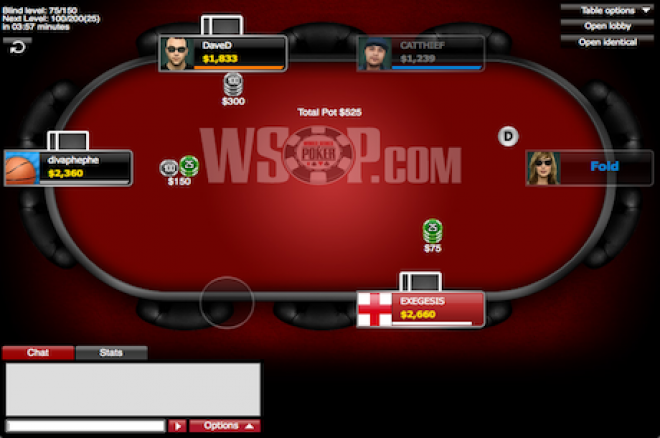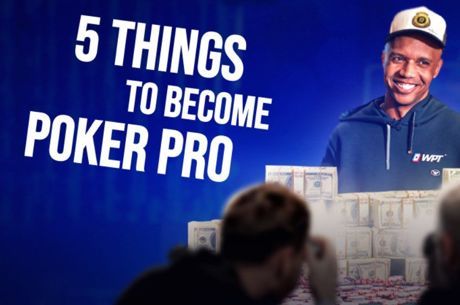PokerNews' Guide To Low-Stakes Sit-N-Gos On WSOP.com


Part of the fun in poker is deciding what kind of game to play. A sit-n-go (SNG) provides a player a great option for tournament-style play without the time commitment of a multi-table tournament. On WSOP.com, there are plenty SNGs to choose from, especially for small stakes where buy-ins range from $1 to $5.
Once in the lobby of the WSOP.com client, select "All Games" and then choose the "Sit & Go" tab. You can filter further by selecting "1-Table," "Qualifiers," or "Heads Up." It will list the available SNGs from smallest buy-in to largest. You can also click on the "Beginners" tab for a quick way into a $1.10 or a $5.50 buy-in one-table SNG.
What Stakes To Play?
The general rule of thumb is the "50 buy-in rule" for SNGs. For whichever stakes you would like to play, allocating at least 50 buy-ins in your bankroll will help you to sustain the variance that can be involved. For the low-stakes SNGs on WSOP.com for example, the $1 level would lend itself to having a $50 bankroll, the $2 level would need a $100 bankroll, and the $5 level would need a $250 bankroll.
Just like in cash games, sticking to your bankroll rules and requirements can go a long way in sustaining your poker life. Don't be afraid to drop down in stakes if you hit a rough patch. Taking a step back will allow you to continue to put in a high amount of volume on the tables while not risking a high percentage of your roll.
Deciding On a Format
For the one-table SNGs, there are six-handed, turbo six-handed, and turbo nine-handed formats to choose from. The six-handed tournaments have blind increases every 10 minutes, while the turbo ones have blind increments at five minutes.
Turbo Six-Handed SNGs
The turbo six-handed SNGs on average finish twice as fast. Because of this, players are forced to play hands. Tight players will get run over, while aggressive players will prosper in the long run. Waiting for good hands is simply not an option. This makes the variance in these tournaments very high. The steep increase in blinds will create a large luck factor at the end of the tournament. For those who want to gamble and play a tournament in a short amount of time, the turbo six-handed format is the way to go.
Regular Six-Handed SNGs
In the regular six-handed SNGs, there is much more time to play, therefore the stacks remain deeper. As in any short-handed game, play is more aggressive than a full-ring table, especially in late position. If you find yourself with a big stack three-handed, you should try to take advantage of the bubble. Only two players get paid, and it’s important to note that first place is more than twice as much as second place. If you can put a lot of pressure on the other two players by raising and playing aggressively, you can build to your chip stack to give you a better advantage once you get heads up.
Turbo Nine-Handed SNGs
The turbo nine-handed SNGs pay three places and the blinds go up every five minutes. Although it is a turbo, the stack sizes in the beginning levels are fairly deep, so there is no need to feel rushed. Basic full-ring SNG strategy is to play tight until you get shorthanded, and then open up your play and aggression from there. As you lose players, continue ramping up the aggression. Again, if you find yourself with a big stack on the bubble, you should try and gain chips from the players who are trying to hang on until the money using pressure.
Heads-Up SNGs
There are times when you might have to wait for the bigger SNGs to fill up, but if you’re in a hurry, hop in a heads-up SNG. Heads-up SNGs are a great way to get in a lot of hands in a short amount of time, and all you have to do is beat one opponent to make money! For small stakes, you can play a $1, $2, or $5 heads-up match. On WSOP.com, all heads-up SNGs are turbos so the blinds go up every five minutes.
In heads-up play, five minutes is plenty of time, so again, don’t feel rushed! Play your game and assess your opponent's aggression level. This will be increasingly important as the blinds get bigger. You will know whether you can bluff your opponent easily with raises and continuation bets or if you need to slow play your hands because he or she is aggressive. Many pros would argue that playing heads up is the quickest way to improve hand-reading skills.
SNGs are a great way to build a bankroll, especially when there are so many low-stakes games available. If you would like to review your play, you can find your SNG tournament history by clicking on "My Profile," then "Game History" in the menu. Under that you will see a button for SNG tournaments. Once you’ve mastered and crushed the low stakes, there are plenty of mid-stakes SNGs on WSOP.com for you to move into next and learn to dominate.
For more strategy tips, tricks, tutorials, podcasts, and more, head to the PokerNews.com Strategy section of the site and start exploring today!








